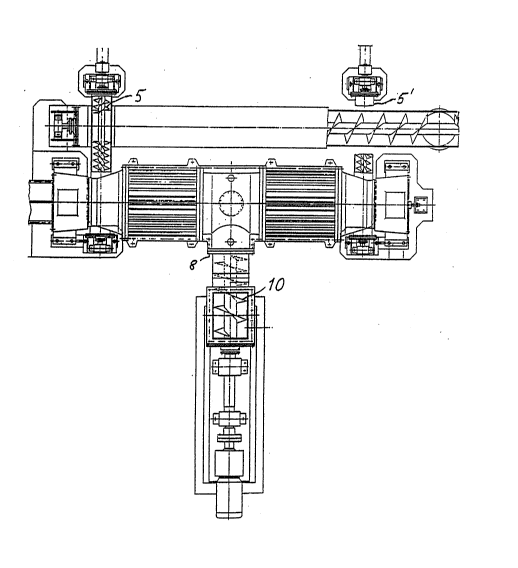Note: Descriptions are shown in the official language in which they were submitted.
`~ x
-
21020~ ~
--1--
Hans Henrich
SUBSTANCE KNEADER
BACKGROUND OF THE INVENTION
The invention concerns a substance kneader,
specifically for cellulose fiber suspensions. Such a
kneader is known from Paper Technology, July, 1973, pages
196 through 202, respectively, T 136 through T 142.
Such machines process fiber materials at
consistencies between generally 26 to 35% and at an
elevated temperature generated by a steam supply. A worm
conveyor i8 provided, which feeds the substance to the
kneader, and a compression worm immediately precedes the
kneading elements of the rotor. Concerned here are ~-
machines having a housing which on one end features an
inlet, and on the opposite end features an outlet.
When treating the substance, generally referred to
as fiber suspension, rather high pressures are required
so that relatively high axial forces occur on the rotor
and, thus, on their bearings. Of course, the treatment
must be such that all fiber ingredients will be affected
at maximum uniformity. Also required is an appropriately
long treatment time, which amounts to approximately 20 s. ~ ;
With machines of prior design, the treatment time ~;
for the individual fibers of a charge was essentially the
same. At very high throughputs, however, appreciable
difficulties arose in the design of the machine.
1 25 The problem underlying the invention is to provide a
kneader which enables high amounts of throughput also at
very high treatment pressures.
SUMMARY OF THE INVENTION
This problem is solved through the features of the
present invention.
A substance kneader, specifically for cellulose
fiber susp2nsions, has kneading elements arranged at the
2102~
z .
periphery of a rotor encased in a housing. Two drum type
rotor parts have a rotor part disposed in between
featuring a feed worm conveyor for each drum type rotor
part. In the area of the mutually facing ends of the
feed worm conveyors, and symmetrical to this area, is an
inlet opening of the housing. At the opposite ends of
the rotor parts aré outlet openings of the housing, with
delivery worm conveyors coordinated with each of the
outlet openings.
An exact setting of throughput amounts or, `~
specifically, of the treatment time of the fibers can be -~
accomplished through the delivery worm conveyors. The
essentially symmetrical design of the machine makes
bearing loads resulting from the axial forces of the
rotor very insignificant. As a result, all fibers will
be subjected to essentially the same specific expense of
effort.
8RIEF DESCRIPTION OF THE DRAWINGS
The invention will be illustrated hereafter with the
aid of the drawing figures. `
Fig. 1 shows a plan view of the inventional kneader,
partly in section;
Fig. 2 shows a partial axial section through the
kneader; and
Fig. 3 shows basically a cross section of the
machine.
DETAILED DESCRIPTION OF T~E INVENTION
Arranged centrally, or concentrically, in the
housing 1 is a rotor consisting of rotor parts 4, 4' and
6, with the rotor parts 4 and 4' supporting the kneading
elements 12. Also, the stator is fixed to housing 1.
The rotor part 6 essentially features a feed worm
conveyor 2, 2' for each of the rotor parts 4 and 4'
respectively. The inlet opening 8 is arranged
21020~
-3-
symmetrical to the feed worm conveyor region contained
between the rotor parts 4 and 4', and it is preceded by a i
feed worm conveyor 10. -;
The feed worm conveyors 2 and 2' effect a respective
compression of the fiber suspension, in order to be able
to maintain the respective pressure in the housing. -
Also contained in this housing region is a closable ~ -
opening 13 for the supply of steam and chemicals. The
delivery openings 15 and 15', respectively, at the axial
ends of the housin~, are arranged in its lower area in
the form of ring sectors, more axially than radially. In
this region, a delivery worm conveyor 5 and 5',
respectively, each extends transverse to the axis of
rotation of the rotor. The delivery worm conveyors may
each include a variable-RPM drive for control of
throughput and/or dwell time of the substance to be
kneaded.
The time of fiber passage through the housing is
e~sentially controlled by regulating the speed of
rotation of these worm conveyors. Resulting thereo~ is a
control of the level of compression and power consumption
in both kneading spaces. The delivery worm conveyors, of
course, run essentially in synchronism.
Additionally, the following is achieved through the
feed worm conveyor: a fiber suspension plug of rather
high consistency (as stated above) is created, enabling
the two feed worm conveyors 2 and 2' to then distribute
the entire throughput evenly to the two rotor parts 4 and
4', respectively, and the corresponding kneading spaces.
While this invention has been described as having a
preferred design, the present invention can be further
modified within the spirit and scope of this disclosure.
This application is therefore intended to cover any
variations, uses, or adaptations of the invention using
21020~
--4--
its general principles. Further, this application is
intended to cover such departures from the present ~.
disclosure as come within known or customary practice in : :
the art to which this invention pertains and which fall :~ ~
within the limits of the appended claims. ~:
